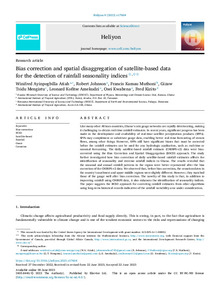| dc.contributor.author | Atiah, W.A. |
| dc.contributor.author | Johnson, R. |
| dc.contributor.author | Muthoni, F.K. |
| dc.contributor.author | Mengistu, D.K. |
| dc.contributor.author | Amekudzi, L.K. |
| dc.contributor.author | Kwabena, O. |
| dc.contributor.author | Kizito, F. |
| dc.date.accessioned | 2023-08-14T10:01:14Z |
| dc.date.available | 2023-08-14T10:01:14Z |
| dc.date.issued | 2023-06-22 |
| dc.identifier.citation | Atiah, W.A., Johnson, R., Muthoni, F.K., Mengistu, D.K., Amekudzi, L.K., Kwabena, O. & Kizito, F. (2023). Bias correction and spatial disagregation of satellite-based data for the detection of rainfall seasonality indices. Heliyon, 9(7): e17604, 1-13. |
| dc.identifier.issn | 2405-8440 |
| dc.identifier.uri | https://hdl.handle.net/20.500.12478/8238 |
| dc.description.abstract | Like many other African countries, Ghana’s rain gauge networks are rapidly deteriorating, making it challenging to obtain real-time rainfall estimates. In recent years, real-time satellite precipitation products (SPPs) development and accessibility have advanced significantly. SPPs may compliment or substitute gauge data, enabling better real-time forecasting of streamflows among other things. SPPs, on the other hand, contain considerable biases that must be addressed before the rainfall predictions can be applied to any hydrologic purpose, including seasonal or real-time forecasts. The Bias Correction and Spatial Disaggregation (BSCD) method was used in this study to bias correct daily satellite-based rainfall estimate (CHIRPS-v2) data. The researchers also looked at how the bias adjustment of daily satellite-based rainfall estimates influences the identification of seasonality and extreme rainfall indices in Ghana. The results revealed that the seasonal and annual rainfall patterns in the region were better represented after the bias correction of the CHIRPS-v2 data. We observed that, before bias correction, the cessation dates in the country’s southwest and upper middle regions were slightly different. However, they matched those of the gauge well after bias correction. The study, therefore, recommends the BCSD method for adjusting rainfall estimates from other techniques with extensive historical data that are indicative of the variability in rainfall for the specified location. |
| dc.description.sponsorship | United States Agency for International Development |
| dc.format.extent | 1-13 |
| dc.language.iso | en |
| dc.subject | Corrections |
| dc.subject | Satellites |
| dc.subject | Rainfall Pattern |
| dc.subject | Forecasting |
| dc.subject | Ghana |
| dc.title | Bias correction and spatial disaggregation of satellite-based data for the detection of rainfall seasonality indices |
| dc.type | Journal Article |
| cg.contributor.crp | Maize |
| cg.contributor.affiliation | Kwame Nkrumah University of Science and Technology |
| cg.contributor.affiliation | International Institute of Tropical Agriculture |
| cg.contributor.affiliation | Botswana International University of Science and Technology |
| cg.coverage.region | Africa |
| cg.coverage.region | West Africa |
| cg.coverage.country | Ghana |
| cg.coverage.hub | Eastern Africa Hub |
| cg.coverage.hub | Headquarters and Western Africa Hub |
| cg.researchtheme | Biometrics |
| cg.researchtheme | Natural Resource Management |
| cg.identifier.bibtexciteid | ATIAH:2023 |
| cg.isijournal | ISI Journal |
| cg.authorship.types | CGIAR and developing country institute |
| cg.iitasubject | Agronomy |
| cg.iitasubject | Climate Change |
| cg.iitasubject | Food Security |
| cg.iitasubject | Maize |
| cg.iitasubject | Meteorology and Climatology |
| cg.iitasubject | Plant Breeding |
| cg.iitasubject | Plant Production |
| cg.journal | Heliyon |
| cg.notes | Open Access Journal; Published online: 28 Jun 2023 |
| cg.accessibilitystatus | Open Access |
| cg.reviewstatus | Peer Review |
| cg.usagerightslicense | Creative Commons Attribution-NonCommercial-NoDerivatives 4.0 (CC BY-NC-ND 4.0) |
| cg.targetaudience | Scientists |
| cg.identifier.doi | https://doi.org/10.1016/j.heliyon.2023.e17604 |
| cg.iitaauthor.identifier | Fred Kizito: 0000-0002-7488-2582 |
| cg.futureupdate.required | No |
| cg.identifier.issue | 7: e17604 |
| cg.identifier.volume | 9 |

